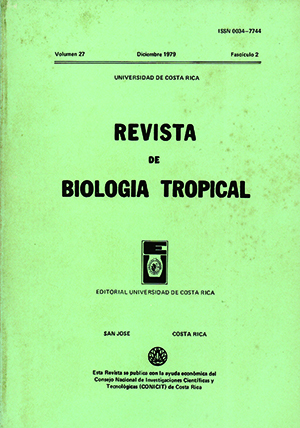Abstract
Allelopathic substances were found in vegetative and reproductive structures of cypress (Cupressus lusitanica Mill.); aqueous extracts inhibited seed germination in three weed species: Lepidium costaricensis, Bidens pilosa and Rumex crispus. The amount of the inhibitor produced by cypress decreases significantly during the dry season. No soil persistance of the inhibitor was observed. The weed seeds begin to germinate normally after 8-10 days of treatment with aqueous extracts or after being washed with tap water. However, when seeds were treated with the essential cypress oils, no recovery of germination capacity was observed. The inhibitor did not show any effect on cypress seeds. This study suggests that cypress should not be used for reforestation in areas of steep slopes and heavy rainfall. In these sites the establishment of cypress forest could favor degradation instead of soil improvement.
References
Bonner, J. 1950. The role of toxic substances in the interactions of higher plants. Bot. Rev., 16: 51-65.
Borner, H. 1960. Liberation of organic substances from higher plants and their role in soil sickness problems. Bot. Rev., 26: 393-424.
Eyenari, M. 1949. Germination inhibitors. Bot. Rev., 15: 153-194.
Langford, A.N., & M.F. Buell. 1969. Integration, identity and stability in the plant association, p. 83-135. In J. Cragg (ed.). Adyances in ecological research. Academic Press.
Le Toumeau, D., & G.D. Failes. 1956. The effect of aqueous extracts of plant tissue on germination of seeds and growth of seedlings. Weeds, 4: 363-368.
Loehwing, W.F. 1937. Root interactions of plants. Bot. Rev., 3: 195-239.
Muller, C.H. 1966. The role of chemical inhibition (allelopathy) in yegetationaI composition. Bull. Torrey Bot. Club, 93: 332-351.
Muller, C.H., & Ch. Chan-Hung. 1972. Ph Phytotoxin:an ecological phase of phytochemistry, p. 201-216. In J.B. Harborne (ed.). Phytochemical Ecology. Academic Press.
Muller, C.H., & R. del Moral. 1966. Soil toxicity induced by terpenes from Salvia leucophylla. Bull. Torrey Bot. Club, 93: 130-137.
Webb, L.J., & L.C. Tracey. 1967. A factor toxic to seedlings of the same species associated with living roots of the nongregarious subtropical rain forest tree Grevillea robusta. J. Appl. Ecol., 4: 13-25.
Went, R.W. 1970. Plant and chemical environment, p. 71-82. In E. Sondheimer y J.B . Simeone (eds.). Chemical Ecology. Academic Press.
Wittaker, R.H. 1965. Dominance and diversity in land plant communities. Science, 147: 250-260.
Wittaker, R.H. 1970. The biochemical ecology of higher plants, p. 43-70. In E. Sondheimer, y J.B. Simeone (eds.). Chemical Ecology. Academic Press.
Woods, F.V. 1960. Biological antagonism due to phytotoxic root exudates. Bot. Rev., 20: 546-595.

This work is licensed under a Creative Commons Attribution 4.0 International License.
Copyright (c) 1979 Revista de Biología Tropical

